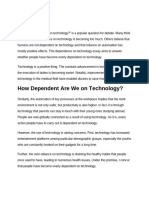Technology Makes Us Smart
Technology Makes Us Smart
Uploaded by
api-254042694Copyright:
Available Formats
Technology Makes Us Smart
Technology Makes Us Smart
Uploaded by
api-254042694Original Title
Copyright
Available Formats
Share this document
Did you find this document useful?
Is this content inappropriate?
Copyright:
Available Formats
Technology Makes Us Smart
Technology Makes Us Smart
Uploaded by
api-254042694Copyright:
Available Formats
Is Technology Making Us Smarter?
Kyle Lavender
Western Oregon University
July 10, 2014
Introduction
As our time on this earth continues, the relationships between humans and
technology have become far more dependant than we could have ever imagined. Cell
phones can perform nearly any task they are required to perform, our computers hold the
keys to all of our personal information and we rely on different forms of technology to
perform every day tasks. This enormous spike in technology use over the past few years
has caused many to believe that our technology is beginning to endanger our intellectual
capacity. In other words, some believe technology is making us dumber. On the other
hand, there are those who feel that this rise in technology use has actually benefited our
overall knowledge, creating new and improved ways of thinking and seeing our world.
As an avid user of new forms of technology, I believe the benefits of technology use far
outweigh the risks and can only improve the way we function as a society. Yes we spend
numerous amounts of hours looking at our computer and hand held device screens, but
we are benefiting from every passing moment. New technology devices allow us to think
more abstractly, communicate and collaborate with others, engage in educational games
and activities, and increase our overall intelligence. Technology is not making us dumb,
but rather smarter and more aware. This will be explained by examining the amount of
time we spend with technology, how we can be better thinkers with new forms of
technology, how we can better connect to others from around the world, games that can
be used to educate, and by taking a closer look at the phenomenon called the Flynn effect.
Time Spent with Technology
The main argument of how technology has made society dumber includes the
amount of time is spent with these new forms of technology. Younger students, usually
born after 1990 and the boom of technological dependence have been known to develop
the necessary skills to operate these technologies much faster than the older generations.
This notion was based solely on the theory that these young students are learning and
developing much quicker than their older predecessors. This is simply not true.
In reality, these younger humans have more time on their hands to spend
operating these new devices and software, finding new ways of utilizing its attributes to
better fit their needs. The older generations who have jobs or family priorities find
themselves with less time to discover how new technology works, making them seem like
the less intelligent population when in reality, they are simply less technologically sound.
Yes, the younger generation may feel more comfortable with a lot of social media, but
they do not understand how they work. They might be comfortable using Google but
they dont understand how its ranking information and theyre not very critical
consumers of it (Wai 2013). Our global society labels these younger technology users as
being smarter than the old when in reality; the level of intelligence towards technology
has remained the same over time. The amount of exposure to that new device is what
really determines that persons level of technological skill and awareness, not age. Some
argue that the next generation of older people will be more tech-savvy because they will
have worked with technology for longer periods of time (Wakefield, 2012). As users
spend more time working with these new pieces of technology, the overall awareness of
its capabilities increases.
Abstract Thinking with Technology
Even with more time spent using new forms of technology, there are those who
still believe we allow technology to think for ourselves and limit our abilities to think
abstractly. When one tries to explain the act of thinking, the common theme is a picture
of someone by himself or herself, sitting in silence, pondering with a hand under their
chin. A perfect example is Auguste Rodins statue The Thinker. The statue is of a man
so isolated he is naked, sitting on a rock with his fist under his chin and a puzzled look on
his face. Those who have seen this statue and understand its meaning automatically think
of this visual metaphor when we hear the word thinking. Cognitive psychologists have
noticed over many years of study just how much thinking involves the people and world
around us. Clive Thompson, author of Smarter Than You Think believes that although
independent thought is incredibly important, an enormous amount of our thinking
happens when we interact with the tools and other individuals around us.
Increasing Connection
These new forms of technology allow the opportunity to express our thoughts
while hearing the opinions and ideas of others at the same time; creating an intelligence
loop that continues to grow over time. I think the thing that makes people nervous and
understandably so about technology is that it opens up the world to new forms of social
thinking. It amplifies social thinking because it allows us to sample and talk to more
people and in more and different ways (Wai 2013). Many have seen computers, the
main source of this social interaction, as a distraction because of the way they are
designed. Society confuses the poor ergonomics of an average computer with the thought
that being quiet and alone is the only way to have real thinking occur. This confusion has
developed a belief that real thinking occurs within the mind, when in reality; simply
thinking within the mind is not even the most important form. It is necessary and vital to
have the outside stimulus from other minds to compare and rethink our own opinions.
Before online software like Google Docs and Soundcloud, where users can
engage in conversation with others on numerous subjects, technology users were
extremely limited in the amount of collaboration and knowledge building they could have
between peers. If someone wanted to discuss new ways to brew beer with other brewers,
they would need to physically travel to another location and seek out those people. Now,
with a simple use subject lines and headers, users can start conversations with people
from across the globe about brewing techniques. The same type of collaboration can be
seen throughout forms of technology, including videogames, which were once considered
a waste of time.
Games for the Brain
Videogames have been labeled as a distraction from effective thinking, allowing
users to zone out and let their fingers do the thinking. Fortunately, studies have begun
to see the complete opposite. According to Jonathan Wai of Duke University, in a paper
now in press, the researchers speculate that the ubiquity of sophisticated video games --
and even some television shows -- may provide a training ground that enhances the
problem-solving skills needed for IQ tests (Folger 2012). Todays videogames have
become so in-depth that the skills required to manipulate its controls require a level of
technological understanding that has not been seen before. And the average age of the
users of these games has steadily decreased as well, allowing for a younger generation to
begin playing these games earlier on in their development. Yes, there are those few
games that require little mental activity from the user in order to participate fully, but
those that are considered good games include a system that is complex, requiring
players to learn and develop through strategy and feedback from the game.
Loyalist College in Ontario offers its students a simulation of the U.S./Canada
border crossing in videogame form. During gameplay, students played the role of guards,
and actually saw the rate of successful test scores jump from 56% to 95% over a two-
month period (Steinberg 2011). These students were given the opportunity to work in a
simulated environment where mistakes were used as a tool to improve performance.
Because students were given the chance to fail and learn from their mistakes, their overall
development increased dramatically. Health care has begun to use the same type of
training tool for its upcoming doctors and nurses. Students can work in a simulation
where decisions need to be made quickly and time is limited. These practices are a much
safer alternative to using real patients and can save the hospital quite a bit of money. Dr.
Jeffrey Taekman, director of Duke Universitys Human Simulation and Patient Safety
Center explains, gaming platforms will offer an interactive way for students to learn and
apply information in context (Steinberg 2011). In the near future, we may begin to credit
videogames for saving a patients life. Furthermore, with the many new forms of gaming
consoles, cell phones, computers and tablets, critics would believe that the time spent
using these devices in a non-educational setting has begun to lower overall intelligence
scores for young students. Fortunately, studies like that of Loyalist College have shown
the opposite.
The Flynn Effect
Thirty years ago, a researcher at the University of Otago in New Zealand named
James R. Flynn discovered a certain phenomenon still being studied today. He noticed
that IQ scores in students throughout the middle and high school levels have been
steadily increasing since the beginning of the 20
th
century.
Flynn went on to examine intelligence-test data from more than two dozen
countries and found that scores were rising by 0.3 point a year -- three full
points per decade. Nearly 30 years of follow-up studies have confirmed
the statistical reality of the global uptick, now known as the Flynn effect.
And scores are still climbing (Folger p. 1, 2012).
Flynn determined that whether or not students were using forms of technology
throughout the day, their intelligence scores continued to rise. We not only benefit from
the interactions with school classrooms and textbooks, but with technology use as well.
Flynn explains the relationship between technology and our educational culture by
comparing them to the development of our cars and roads. During early development, the
overall speeds of the first automobiles were very slow due to the poor construction and
uneven surfaces of the roads. Over time, our cars and roads co-evolved. Developers
began creating faster cars that could drive on the improved flattened roads.
Our minds and culture are locked in a similar feedback loop. We are
creating a world where information takes forms and moves with speeds
unimaginable just a few decades ago. Every gain in technology demands
minds capable of accommodating the change, and the changed mind
reshapes the world even more. The Flynn effect is unlikely to end during
this century, presaging a future world where you and I would be
considered woefully pre-modern and literal (Folger p. 2, 2012).
Flynns feedback loop is what makes learning possible. We input information into our
educational system and make adjustments from the feedback we received. This can be
seen throughout any videogame, interactive television show and simulated training
program on the market. Much like the construction of our roads, technology requires the
same developmental process. As new advances in technology appear, the minds that
control the technology need to be able to adapt and learn as they go.
Conclusion
Without technology, our intelligence levels would be decades behind where we
are now. There are now ways of seeing our world, collaborating with others, and sharing
information that seemed impossible before the technological advances of the past
decades. Videogames, which were once viewed as a waste of time, have now been
developed to help aid student development in the classroom. The ability to connect with
others has made collaboration more readily available to anyone with an Internet
connection, and with constant use of these new forms of technology, students will begin
to develop their intellectual abilities at a much quicker rate. Technology does not make
use dumb. Rather, technology enhances our intelligence because it provides us the tools
to instantly discover new things about our world and allows a feedback loop that is ever
evolving. Technology is like life, in that it always desires improvement. Wire magazine
founder Kevin Kelly explains in his book What Technology Wants, Technology wants
what life wants: Increasing efficiency; Increasing opportunity; Increasing emergence;
Increasing complexity; Increasing diversity; Increasing specialization; Increasing
ubiquity; Increasing freedom; Increasing mutualism; Increasing beauty; Increasing
sentience; Increasing structure; Increasing evolvability (Kelly p. 386). With equal desires,
technology and life will forever have a constant connection. They both desire positive
development that enhances our way living. Without this constant need for improvement,
our lives would be like the old roads of early industrial times; bumpy and uneven.
Technology looks to smooth this development out creating easier, more efficient ways of
looking at our world today and developing a better tomorrow.
Sources
Folger, T. (2012). Academic Search Premier. Can We Keep Getting Smarter? Scientific
American. September 2012. Vol. 307. Issue 3
Kelly, K. (2010). What Technology Wants. Penguin 2010.
Steinberg, S. (2011). How Videogames Can Make You Smarter. CNN Tech. January 31,
2011. Retrieved from
http://www.cnn.com/2011/TECH/gaming.gadgets/01/31/video.games.smarter.steinberg/
Wu, T. (2014). As Technology Gets Better, Will Society Get Worse? The New Yorker.
February 6, 2014. Retrieved from
http://www.newyorker.com/online/blogs/elements/2014/02/as-technology-gets-better-
will-society-get-worse.html
Wai, J. (2013). Does Technology Make Us Smarter Than You Think? Novermber 24,
2013. Psychology Today. Finding the Next Einstein. Retrieved from
http://www.psychologytoday.com/blog/finding-the-next-einstein/201311/does-
technology-make-you-smarter-you-think
Wakefield, J. (2012). BBC. News Technology. Are the Older Generation Getting Tech-
Savvy?. December 13, 2012. Retrieved from http://www.bbc.com/news/technology-
20529991
You might also like
- Award Ceremony ScriptDocument5 pagesAward Ceremony ScriptDarshnaNo ratings yet
- Flashcards: Jan RichardsonDocument38 pagesFlashcards: Jan RichardsonakrichtchrNo ratings yet
- The Positive and Negative Effects of Technology On ChildrenDocument10 pagesThe Positive and Negative Effects of Technology On Childrentresa_marion100% (1)
- Dissertation Recherche Sciences SocialDocument3 pagesDissertation Recherche Sciences Socialtheobaudin123No ratings yet
- 2020 PresentationDocument10 pages2020 Presentationapi-283125505No ratings yet
- Modern Technology Evolution and Its Effect To High School Students PDFDocument3 pagesModern Technology Evolution and Its Effect To High School Students PDFYanna KyutNo ratings yet
- 12th Grade EssayDocument4 pages12th Grade Essayapi-546580935No ratings yet
- Crojas Litreview FinalDocument16 pagesCrojas Litreview Finalapi-300962109No ratings yet
- Technology and Its Effect On CreativityDocument8 pagesTechnology and Its Effect On Creativityapi-448533807No ratings yet
- SoAInternetandthebrain 0Document98 pagesSoAInternetandthebrain 0Dan SutchNo ratings yet
- Collected Data and Documentation-SynthesisxDocument7 pagesCollected Data and Documentation-SynthesisxSARAH MAE HAPINNo ratings yet
- Practical Research IIDocument11 pagesPractical Research IIlimery panisiganNo ratings yet
- AbstractDocument3 pagesAbstractKenny ChanNo ratings yet
- Technology: Can Technology Help Your Kid?Document5 pagesTechnology: Can Technology Help Your Kid?Oscar ZegarraNo ratings yet
- Paradigm Shift PaperDocument13 pagesParadigm Shift Paperapi-509526960No ratings yet
- Gened 4 M5 L3Document18 pagesGened 4 M5 L3Roel CababaoNo ratings yet
- Running Head: Emotional Intelligence and Technology 1Document16 pagesRunning Head: Emotional Intelligence and Technology 1api-315710457No ratings yet
- Kimhalim Projectspersuasionpart2Document50 pagesKimhalim Projectspersuasionpart2api-215956780No ratings yet
- Final EssayDocument5 pagesFinal Essayapi-459547656No ratings yet
- Technology Makes People Smarter - ArgumentsDocument2 pagesTechnology Makes People Smarter - ArgumentsKirpa RaiNo ratings yet
- The Rise of Social Media and Smart DevicesDocument4 pagesThe Rise of Social Media and Smart Devicesapi-341073492100% (3)
- RRL (Final)Document11 pagesRRL (Final)JbMeraNo ratings yet
- IntroductionDocument7 pagesIntroductioneishamalikhspNo ratings yet
- Exposure To GadgetsDocument25 pagesExposure To Gadgetsrachel cacholaNo ratings yet
- PaolaDocument4 pagesPaolaLao LucasNo ratings yet
- Ams PaperDocument8 pagesAms Paperapi-340244757No ratings yet
- The Effect of Technology On FaceDocument23 pagesThe Effect of Technology On FaceJamie BagundolNo ratings yet
- The Dependence of Technology in Our Time PeriodDocument4 pagesThe Dependence of Technology in Our Time PeriodNickNo ratings yet
- Workplace 1Document10 pagesWorkplace 1Jumardi SingareNo ratings yet
- The Problem and Related LitiratureDocument34 pagesThe Problem and Related LitiratureCarla CarlaNo ratings yet
- Argumentative Essay Final Draft - CCP English 1Document5 pagesArgumentative Essay Final Draft - CCP English 1api-609515608No ratings yet
- IntroductionDocument7 pagesIntroductionapi-256172598No ratings yet
- Jayla Wagoner English 1001 Argumentative Essay FinalDocument6 pagesJayla Wagoner English 1001 Argumentative Essay Finalapi-457753544No ratings yet
- Switches Off Relationship Between People Harm For Human Health, and Decreases Students in Their SkillsDocument8 pagesSwitches Off Relationship Between People Harm For Human Health, and Decreases Students in Their Skillsapi-302998582No ratings yet
- Jenna Ams FinalDocument8 pagesJenna Ams Finalapi-273500826No ratings yet
- Creating A Healthy Balance: Technology AddictionDocument4 pagesCreating A Healthy Balance: Technology AddictionAnurag VishwakarmaNo ratings yet
- Proposal AssignmentDocument8 pagesProposal Assignmentapi-281838327No ratings yet
- "Success in Circuit Lies" - How Do We Cultivate Deep Reading Processes in A Digital Age - ABC Religion & EthicsDocument4 pages"Success in Circuit Lies" - How Do We Cultivate Deep Reading Processes in A Digital Age - ABC Religion & Ethicsharekrushnapurohit1No ratings yet
- View ContentDocument51 pagesView ContentDhruval PatelNo ratings yet
- Literature Review DraftDocument16 pagesLiterature Review Draftapi-273576387No ratings yet
- SSRN 4872178Document15 pagesSSRN 4872178dilawaizjamshaid007No ratings yet
- The Impact of Digital Technologies On Human WellbeingDocument98 pagesThe Impact of Digital Technologies On Human WellbeingAbdullah Rahim RomanNo ratings yet
- Humanity in The Digital AgeDocument18 pagesHumanity in The Digital AgeTomas Silva MontealegreNo ratings yet
- Humanity in The Digital Age: Cognitive, Social, Emotional, and Ethical ImplicationsDocument18 pagesHumanity in The Digital Age: Cognitive, Social, Emotional, and Ethical ImplicationsChess NutsNo ratings yet
- Educating Net GenerationDocument8 pagesEducating Net GenerationJosé Rafael DíazNo ratings yet
- Aveloz LrfinalDocument13 pagesAveloz Lrfinalapi-265975305No ratings yet
- Research PaperDocument12 pagesResearch PaperMarvin Callos LaloNo ratings yet
- Brandon Robinson-BingDocument10 pagesBrandon Robinson-Bingapi-442131201No ratings yet
- To What Extent Has Technology Had A Negative Impact On The Skills Level of PeopleDocument3 pagesTo What Extent Has Technology Had A Negative Impact On The Skills Level of PeopleSamuel Tan Qing HuiNo ratings yet
- What Do We Know About Children and Technology?Document20 pagesWhat Do We Know About Children and Technology?Lucienne100% (1)
- Is Technology Addiction A Real Addiction - English Persuasive Text.Document3 pagesIs Technology Addiction A Real Addiction - English Persuasive Text.Leila FonuaNo ratings yet
- Thesis Statement On Technology AddictionDocument8 pagesThesis Statement On Technology Addictiontiffanymillerlittlerock100% (2)
- TechnologyDocument2 pagesTechnologyyanoy.mc98No ratings yet
- Technology Addiction Lab TemplateDocument9 pagesTechnology Addiction Lab TemplatelelenumerounNo ratings yet
- Worksheet 1Document14 pagesWorksheet 1TcherKamilaNo ratings yet
- The Impact of Technology On KidsDocument4 pagesThe Impact of Technology On KidsOuarour AimaneNo ratings yet
- Quilaton, CG Ge7 Final ExamDocument2 pagesQuilaton, CG Ge7 Final ExamCamelle Grace QuilatonNo ratings yet
- Child Development EssayDocument7 pagesChild Development EssaySharmeen ParanthamanNo ratings yet
- Ethical Considerations in Internet-Based Adult Education: Margaret E. HoltDocument8 pagesEthical Considerations in Internet-Based Adult Education: Margaret E. HoltMersed BarakovicNo ratings yet
- Digital Childhood: Parenting in the Age of ScreensFrom EverandDigital Childhood: Parenting in the Age of ScreensRating: 5 out of 5 stars5/5 (33)
- MICROCURRICULAR PLANNING 1ro BGU PDFDocument4 pagesMICROCURRICULAR PLANNING 1ro BGU PDFCintia Cagua100% (1)
- Participation FormDocument2 pagesParticipation FormAdil ShahzadNo ratings yet
- Suphanburi-Invitation-For All ICEPD MembersDocument4 pagesSuphanburi-Invitation-For All ICEPD MembersMilo O. PlacinoNo ratings yet
- A Detailed Lesson Plan in Science 6Document6 pagesA Detailed Lesson Plan in Science 6Joanna Marie Villamar100% (3)
- Teaching MathDocument41 pagesTeaching MathChrisjann Cangcang100% (6)
- HRDF Annual Report 2017Document155 pagesHRDF Annual Report 2017Hse Consultancy SgsbNo ratings yet
- B Tech Fee Structure 2022-23 Session - CompressedDocument2 pagesB Tech Fee Structure 2022-23 Session - CompressedNeha SahaNo ratings yet
- DLL Q3 W3 Eng 6Document6 pagesDLL Q3 W3 Eng 6Santa Yzabel GuevaraNo ratings yet
- Eric Digest: Carol Ann TomlinsonDocument2 pagesEric Digest: Carol Ann TomlinsonroylepayneNo ratings yet
- G3 QuizDocument2 pagesG3 QuizJohn Michael LaycoNo ratings yet
- Proposed Development Plan For College of Education in Mabini Colleges, Inc.Document11 pagesProposed Development Plan For College of Education in Mabini Colleges, Inc.Psychology and Education: A Multidisciplinary Journal0% (1)
- Mischief Making of One Kind and Another Unruliness and Resistance in Rural Preschoolers Free PlayDocument16 pagesMischief Making of One Kind and Another Unruliness and Resistance in Rural Preschoolers Free PlayJose Luis Ruidias CalleNo ratings yet
- Objective-Related Principles of Teaching: Guiding Principles in Dtermining and Formulationg Learning ObjectivesDocument2 pagesObjective-Related Principles of Teaching: Guiding Principles in Dtermining and Formulationg Learning ObjectivesJose C. Lita JrNo ratings yet
- Direct Speech and Indirect SpeechDocument2 pagesDirect Speech and Indirect SpeechNesta AwNo ratings yet
- OHI Vol.36 No.1 PDFDocument107 pagesOHI Vol.36 No.1 PDFRosamônica LamounierNo ratings yet
- Rescheduled Examinations and Practicals-26032021Document5 pagesRescheduled Examinations and Practicals-26032021Maheswari SNo ratings yet
- Curriculum Map DIASSDocument18 pagesCurriculum Map DIASSMARIA VANESSA PABLONo ratings yet
- Curriculum Vitae: Dias Agata, S.S., M.PDDocument21 pagesCurriculum Vitae: Dias Agata, S.S., M.PDHanif Al AzharNo ratings yet
- Erfan El Mawaldi ResumeDocument1 pageErfan El Mawaldi ResumeOmarHagrass11No ratings yet
- Statement of PurposeDocument2 pagesStatement of PurposeAan DaisyNo ratings yet
- DSKP Form 1Document57 pagesDSKP Form 1sclingNo ratings yet
- Intention-Based Models of Entrepreneurship Education: January 2004Document31 pagesIntention-Based Models of Entrepreneurship Education: January 2004RennyBintoroNo ratings yet
- Chapters Invited For Edited Book BroucherDocument2 pagesChapters Invited For Edited Book BroucherAnbu AndalNo ratings yet
- ATLS Advanced Trauma Life Support For Doctors 8th Edition 2008 USDocument383 pagesATLS Advanced Trauma Life Support For Doctors 8th Edition 2008 USJulio100% (6)
- To Inquire Into The Following:: How We Express Ourselves: An Inquiry Into The Ways in Which We DiscoverDocument4 pagesTo Inquire Into The Following:: How We Express Ourselves: An Inquiry Into The Ways in Which We DiscoverJona CajalaNo ratings yet
- Social Geography Lesson 1Document6 pagesSocial Geography Lesson 1api-313716520No ratings yet
- My Logo - Session PlanDocument3 pagesMy Logo - Session PlanFURKAN BAŞKÖSENo ratings yet
- Epstein Resume December 2020Document1 pageEpstein Resume December 2020api-534313817No ratings yet

























































































